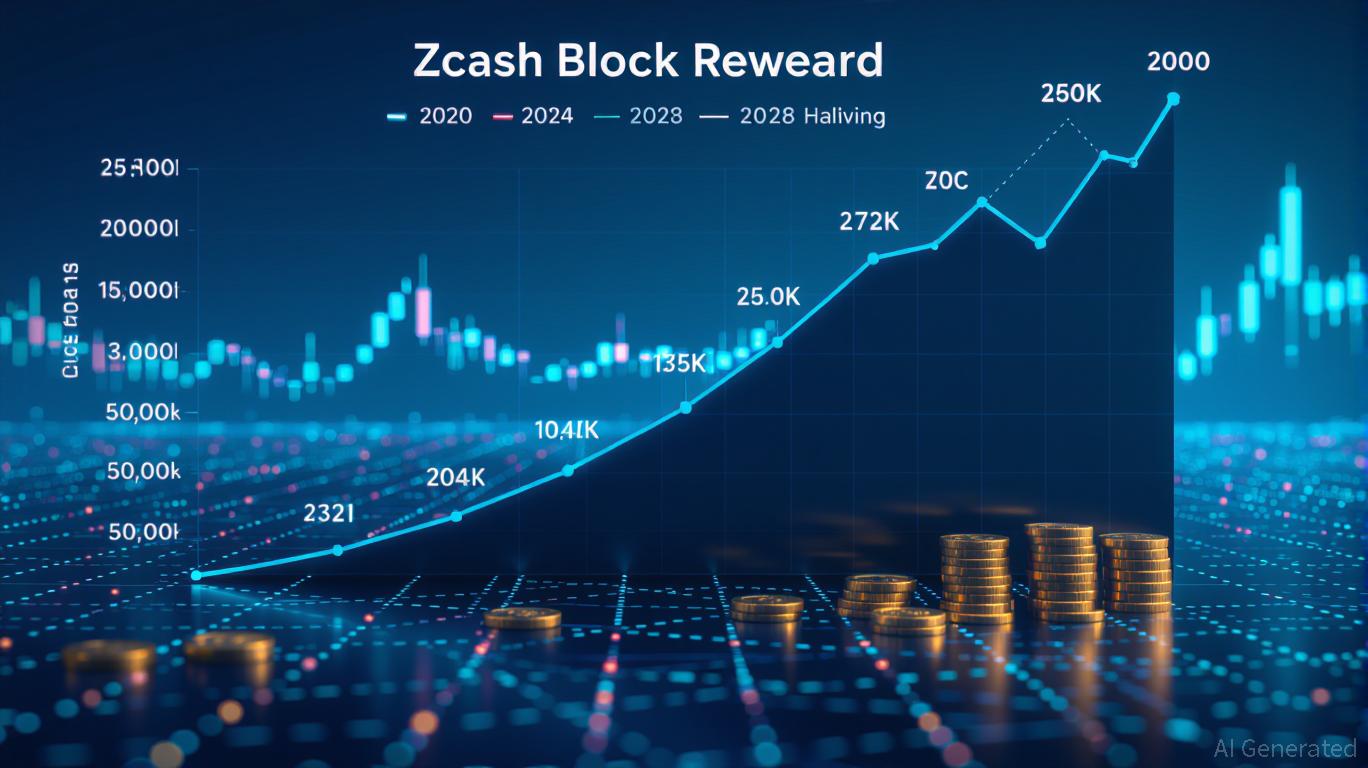Zcash Halving 2025: Impact on Cryptocurrency Markets and Investment Approaches
- Zcash's next halving in late 2028 will cut block rewards to 0.78125 ZEC, accelerating its 21M supply cap. - Historical data shows 500%+ price surges post-halving, driven by scarcity and growing institutional adoption like Grayscale's $137M Zcash Trust. - Privacy-focused demand and counter-cyclical price trends highlight Zcash's unique role, though regulatory risks to shielded transactions persist. - Investors are advised to balance long-term positioning with diversification and monitor utility-driven upg
Blockchain Economics: Limiting Supply and Miner Motivation
Zcash implements a halving every four years, slashing block rewards by half after every 1,680,000 blocks are produced
While Zcash’s deflationary approach is similar to Bitcoin’s, it also introduces its own unique factors. By reducing the rate at which new coins are created, Zcash will see its annual inflation rate drop from 6.25% after 2024 to 4% by the end of 2025

Speculative Demand: Past Trends and Institutional Influence
Looking back, there is a notable link between Zcash halving events and significant price increases. The 2020 halving triggered a 500% surge in value, while the 2024 halving led to a 92% jump by the last quarter of 2025
Greater institutional involvement has also fueled speculative interest. The introduction of the $137 million Grayscale Zcash Trust in 2025
Market Behavior: Divergent Trends and Regulatory Challenges
Zcash’s price movements often contrast with Bitcoin’s, especially during bearish markets. In late 2025, ZEC climbed 750% as investors turned to privacy coins while Bitcoin experienced turbulence
Privacy coins like Zcash continue to face uncertain regulatory environments. Although the SEC’s 2025 decision to exempt PoW mining from securities regulations
Investor Strategies: Key Points to Consider
For those investing in Zcash, understanding the interplay between limited supply, speculative forces, and regulatory uncertainty is essential. Recommended approaches include:
1. Long-Term Holding: With Zcash’s supply steadily decreasing, maintaining positions through multiple halving cycles could offer cumulative returns.
2. Portfolio Diversification: Spreading investments across Zcash and other privacy coins or
3. Tracking Network Developments: Innovations like Zashi and CrossPay may drive demand based on utility, independent of speculative trends
Conclusion
Zcash’s halving cycle provides valuable insight into both blockchain economics and speculative market behavior. Although the next halving is slated for 2028, the aftermath of the 2024 event—characterized by institutional participation and price stability—demonstrates Zcash’s promise as a privacy-oriented asset and a potential store of value. Investors should carefully balance these opportunities with the risks posed by regulatory shifts and market volatility, ensuring their strategies are in step with broader economic trends and the ongoing evolution of the Zcash ecosystem.
Disclaimer: The content of this article solely reflects the author's opinion and does not represent the platform in any capacity. This article is not intended to serve as a reference for making investment decisions.
You may also like
YFI drops 2.95% over 24 hours as market experiences turbulence
- Yearn.finance (YFI) fell 2.95% in 24 hours to $4,851 amid crypto market volatility. - Despite short-term gains (0.96% weekly, 2.52% monthly), YFI has dropped 39.62% over one year. - Traders analyze technical indicators and on-chain data to assess if the dip is a correction or deeper trend. - A backtest evaluates moving averages and volume signals to test strategies for mitigating losses during volatility.
JPMorgan and DBS Highlight Blockchain's Move Toward Real-World International Payments
- JPMorgan and DBS Bank launched a blockchain interoperability framework enabling real-time cross-chain tokenized deposit transfers for institutional clients. - The system connects JPMorgan's Kinexys platform with DBS's Token Services, addressing blockchain network incompatibility to streamline cross-border payments and trade finance. - The initiative aligns with global banks' push for tokenized deposit standards, supported by regulators like Singapore's MAS and potentially influencing future CBDC framewor
Bitcoin Updates Today: Institutional Embrace of Bitcoin Spurs Major Revamp of Threshold’s tBTC Ecosystem
- Threshold Network upgrades tBTC protocol for gasless Bitcoin tokenization, enabling direct minting to Ethereum , Arbitrum, and Sui without bridging or approvals. - Institutional Bitcoin adoption surges to $414B in August 2025, with tBTC facilitating DeFi integration for 172 listed companies holding over 1 million BTC. - Gasless minting reduces operational costs for institutions while new dashboards and DeFi integrations streamline yield strategies and cross-chain liquidity management. - Threshold's 51-of
US Government Reopens After 41 Days – What It Means for Bitcoin, Crypto, and Global Markets